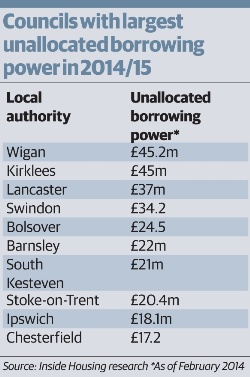You are viewing 1 of your 1 free articles
Feast or famine
Local authorities are campaigning for more freedom to borrow and build. But Keith Cooper discovers that some councils still haven’t touched their £2.9 billion first course
English council housing was expected to enter a brave new world in 2012.
Armed with brand new powers to borrow, local authority landlords were due to sally forth with ambitious spending plans. After decades pinned down by a Treasury-controlled ‘subsidy’ system, they received ‘financial freedoms’ to build new homes and spruce up existing ones, using newly minted ‘self-financing’ housing revenue accounts.
Councils have ever since been asking for more borrowing powers to build the homes needed in their areas.
However, exclusive analysis by Inside Housing reveals this much-trumpeted new era has suffered a somewhat stilted start. Instead of borrowing to invest, many authorities appear to have sat on their hands. And, short on staff and expertise following swingeing cuts to their overall budgets, they appear in need of encouragement and support to make best use of their housing borrowing powers.
Our research indicates that 40 per cent of stock-owning authorities have no plans in place to use the £2.9 billion borrowing capacity the government sanctioned when it reformed the housing revenue account in 2012. Furthermore, much of this potential investment - 57 per cent - will lie dormant this financial year, according to financial data supplied by 118 authorities under the Freedom of Information Act.
While 50 councils plan to borrow £770 million during the 2014/15 financial year, our research identifies a further 50 which have not touched the £1 billion available to them. Of these, Wigan and Kirklees councils report the largest single unexploited loans: £45 million of unused borrowings apiece. Meanwhile, 11 councils have no borrowing power and seven are reviewing their housing investment plans.
Existing loans
Natalie Elphicke, the lawyer heading a government review into council housing, says the findings raise questions about some councils’ approach to housing finance. ‘We need to look at how people are using the freedoms and flexibilities of the self-funding HRA and whether they could be doing more,’ she tells Inside Housing. ‘If there are councils in an area of very strong housing need that don’t have a strategy to use their headroom [borrowing power] or a planned investment strategy, that would be something to really look at.’

The analysis also reveals that many authorities have focused on boosting borrowing capacities - largely by paying off existing loans - during the first two years of self-financing, rather than taking on new debt to invest. Fifty such councils have quietly increased this capacity since 2012/13, by £282 million.
Sandwell Council alone has in this way increased the amount it can borrow by 55 per cent since the self-financing system came in, to £79.9 million in 2014/15. It plans, though, to borrow just 4 per cent of that amount. Meanwhile, despite doubling the amount it can borrow from £11 million to £22 million over the same period, Barnsley Council has not formed any plans to borrow a penny of its loan capacity, despite a predicted housing shortfall of 3,000 homes in the south Yorkshire town over the next decade.
Our analysis appears to undermine the position held by influential lobby groups that the government’s £2.9 billion limit on council borrowing is stymying council housing development. Senior figures from the Chartered Institute of Housing, the Local Government Association and London Councils, among others, all argue that the cap is the main restriction on new council homes.
The CIH says borrowing capacity was poorly matched with housing need under the 2012 self-financing deal. Thanks to the way self-financing was established, half of all council landlords also have ‘very limited headroom or none at all’, according to Gavin Smart, CIH director of policy. ‘Our focus is on the overall restriction [rather than on individual councils],’ he adds. ‘We think this is shutting down the ability to deliver much-needed financial capacity and new homes.’ In other words, please can we have some more?
Yet figures from February and March 2014 challenge this position: the vast majority of council landlords already appear to have sufficient loan capacity to get some housing development going. Almost 90 per cent can borrow more than £1 million and nearly 70 per cent have borrowing caps of more than £5 million.
This suggests the need to address a raft of other significant difficulties preventing council housing development. So if the cap is not to blame, what is behind councils’ apparent reluctance to borrow? And what might encourage them to do more of it?
The councils and financial advisers with whom Inside Housing has shared this research point to three main reasons stopping councils from putting their borrowing capacity to work: welfare reform; lack of confidence and capacity; and reluctance to increase their debt.
Adrian Waite, director of consultancy AWICS, knows of several authorities that are simply averse to taking on extra loans, despite residents’ desperate demand for new housing. ‘They view it [new debt] as a bad thing, want to pay it off and don’t want any more. That approach is viewed in some councils as being more prudent. But I am not sure it is particularly logical.’
Such councils act like retiring officials, instead of the large institutional landlords they are, Mr Waite argues. ‘It comes from thinking about what they would do personally,’ he adds. ‘People think about paying off debt before they retire. But councils don’t retire. Future generations might want housing to live in to tackle the social problems we see and have more debt in the HRA.’
Prudent approach
One authority disinclined to shoulder more debt is Swindon. Its borrowing power has increased 42 per cent since 2012, up to £34.2 million in 2014 to 2015. Instead of using this loan capacity, however, the 10,400-home landlord has focused on repaying the £139 million it borrowed under the 2012 self-financing deal. Such a sizeable loan had to be carefully managed, an authority spokesperson says: ‘Any additional debt that we take on must generate an income that repays itself within a reasonable payback period so that we do not increase the debt burden.’
After more than two years denting its debt (by an unspecified amount), Swindon is now gearing up for a house building programme that aims to combine its borrowing powers with affordable housing grant from the Homes and Communities Agency. ‘This is the first opportunity to do so since self-financing commenced,’ a spokesperson says.
Further north, Barnsley is among the councils which cite welfare reform as a reason for avoiding extra debt. This 19,000-home landlord sees the social security shake-up as the ‘biggest current risk’ to its housing finances. Government plans to pay benefits directly to tenants instead of landlords under the new universal credit regime could ‘seriously undermine the viability’ of its housing business, a spokesperson says. None of its £22 million borrowing power will be touched until ‘the position on welfare reform becomes clearer’, she adds.
Welfare reform is prompting authorities to rethink and reshape their HRA plans but not, according to our analysis, by borrowing more.
Lancaster Council’s loan ceiling has risen 23 per cent to £37 million during the past two years, and it is now about to embark on a development programme primarily focused on small flats. This aims to help around 500 tenants who are adversely affected by the bedroom tax, as well as shorten its 3,100-home waiting list. But not a bean of its burgeoning borrowing power will be used as it dips its toe into the house building trade. The city will instead fund development from £8.5 million of HRA reserves.
Karen Leytham, cabinet member for housing at the 3,807-home landlord, says new housing is a ‘key priority’ for the council. The city will only consider borrowing, a spokesperson adds, following ‘further assessment’ of housing demand.

Another council seeking to reshape its plans in the face of welfare reform is Wigan, the 22,600-home authority with the largest unexploited borrowing power in our list. Paul Kenny, cabinet member for housing, says Wigan plans to borrow in the ‘medium-term’ to meet demand ‘flowing from welfare reforms’. Wigan intends to progressively call on its loan capacity over the 30-year life of its business plan, a spokesperson adds. This capacity ‘shouldn’t be portrayed as a one-off spending opportunity’, she says.
This long-term view is supported by Steve Partridge, a housing consultant who helped construct the new self-financing system. Council landlords, like any business, would be unwise to exhaust loan capacities immediately. ‘It isn’t solid business practice to borrow up to your limit,’ he adds. ‘Housing associations don’t borrow up to the maximum capacity. There is some hedging going on.’
Mr Partridge says some councils may demur from exploiting their borrowing powers because they lack financial skills and confidence. With local authority budgets and headcounts ‘savaged’ by Treasury cuts, housing departments may now lack the support of essential council services, such as development teams, to orchestrate large investment plans.
‘If you want to deliver a big investment programme you need support from [your council’s] central services. They are being savaged,’ he says. ‘At the very time when you have the resources to invest in housing, the capacity to deliver programmes has been reduced significantly because of local government cuts.’
Such capacity issues do appear to be reducing many councils’ housing ambitions. For example, despite possessing £32 million of borrowing power in 2012, Kirklees Council is still ‘exploring the best [house building] model to ensure value for money’, according to a spokesperson. The 23,000-home authority is also considering increasing housing supply by working with housing associations and private developers, she adds.
Lancaster’s development plans also appear to have been beset by capacity issues. The landlord last built homes in 1995. Last year officers warned councillors that the city lacked ‘the internal organisational experience’ to build homes and it is considering appointing an external consultancy to support its house building ambitions.
This struggle to rediscover the skills, models and means to build new homes has been recognised by the Communities and Local Government department. Ms Elphicke’s review aims to help councils boost supply, a CLG spokesperson says. Ministers welcome the ‘quiet resurgence’ in council house building but want authorities ‘to go further’, he adds.
Ms Elphicke says enabling councils to boost their development capacity is ‘central’ to the review. ‘We don’t want to make judgements about whether a council is not taking action but we need to understand why they don’t feel that they can, particularly in areas where there is strong housing need,’ she adds.
Councils that simply chose not to fulfil their ‘obligations’ to help residents with housing need should, though, face scrutiny, argues Ms Elphicke. ‘I certainly think that looking at what people have been doing and why people haven’t been doing things is an important part of our project,’ she says.
Given the evidence of this analysis, the outcome of Ms Elphicke’s review and its recommendation will be crucial to the future of England’s council homes. It’s not just the cap keeping them back - many need help to come up to the table.
Borrowing power in figures
170
local authority landlords in England
42%
councils with borrowing power but no plans to use it as of February 2014
£2.9 billion
total borrowing power available in 2012
57%
proportion of borrowing power unallocated as of February 2014
£282 million*
increase in loan capacity since self-financing began (*Based on results from 50 authorities where headroom has increased since 2012)












